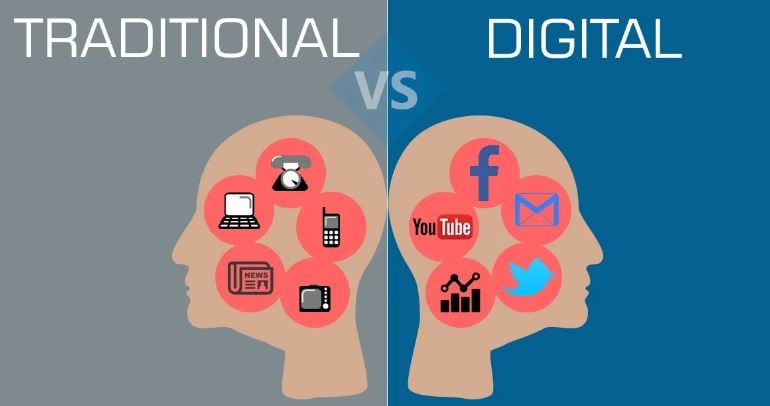In the competitive fitness industry, marketing plays a pivotal role in attracting and retaining gym members. Today, gym owners face a conundrum: should they stick with traditional marketing methods or embrace the digital age?

The answer isn't black and white. Both digital and traditional marketing strategies have their merits and drawbacks. To achieve optimal results for your gym, a balanced approach that combines the strengths of both is often the key to success.
Understanding the two approaches
Traditional marketing
Traditional marketing encompasses offline strategies that have been around for decades. Some common forms include:
- Print media: This includes flyers, posters, and brochures distributed at local businesses or mailed to potential customers.
- Television and radio ads: Gyms can use commercials on local TV or radio stations to reach a broad audience.
- Billboards: Outdoor advertising in high-traffic areas can effectively increase gym visibility.
- Direct mail: Mailing physical newsletters, postcards, or coupons to local residents.
- Event sponsorships: Partnering with local events to increase brand visibility.
Digital marketing
Digital marketing leverages online platforms and channels to promote your gym. Key digital marketing strategies include:
- Website and SEO: A well-designed website with strong search engine optimization (SEO) helps potential members find your gym online.
- Social media marketing: Platforms like Facebook, Instagram, and Twitter enable gym owners to engage with the community and run targeted ads.
- Email marketing: Building a subscriber list and sending regular newsletters can help maintain member engagement.
- Content marketing: Creating valuable, fitness-related content through blogs, videos, and podcasts can attract and retain members.
- Paid advertising: Using online advertising platforms such as Google Ads and Facebook Ads to reach a broader audience.
The positives and negatives of each approach
Traditional marketing
Positives:
- Local presence: Traditional marketing methods can be highly effective for local visibility and connecting with the immediate community.
- Tangibility: Physical materials like flyers and billboards are tangible, which can leave a lasting impression on potential members.
- Targeted demographics: Certain traditional methods, like sponsoring local events, allow for targeted marketing to specific demographics.
Negatives:
- Limited reach: Traditional marketing has a limited reach, making it challenging to target a broader audience beyond the local community.
- Higher costs: Printing and distributing materials, along with running TV or radio ads, can be costly compared to digital options.
- Difficult to measure: Tracking the success of traditional marketing campaigns can be challenging, making it difficult to adjust strategies in real-time.
Digital marketing
Positives:
- Global reach: Digital marketing opens up opportunities to reach a global audience, expanding your gym's potential member base.
- Cost-effective: Many digital marketing strategies are more cost-effective than traditional methods, making them ideal for gyms with limited budgets.
- Data-driven insights: Digital marketing allows for precise tracking and measurement of campaigns, providing valuable insights into what works and what doesn't.
Negatives:
- Saturation: With the increasing prevalence of digital marketing, the online space can be saturated, making it challenging to stand out.
- Learning curve: Effectively managing digital marketing campaigns requires a learning curve, and mistakes can be costly.
- Privacy concerns: Increasing concerns about data privacy may limit the effectiveness of some digital advertising methods.
The best marketing strategy for your gym doesn't require choosing between digital and traditional methods but leveraging the strengths of both. Here's how to synchronize these approaches for optimal results:
- Create an engaging website: Start by building a user-friendly website optimized for local SEO. This acts as your gym's online hub, providing information about your services, classes, and trainers. Include sign-up options and calls to action to convert website visitors into members.
- Leverage social media: Use platforms like Facebook and Instagram to create a strong online presence. Share engaging content, promote special offers, and encourage members to leave reviews. Running targeted ads on these platforms can help you reach potential members in your area.
- Email marketing: Combine your online and offline efforts by collecting email addresses through your website and during in-person interactions. Send regular newsletters that include promotions, fitness tips, and member success stories.
- Content marketing: Create valuable content that showcases your gym's expertise. Blog posts about fitness trends, workout routines, and healthy living can help establish your gym as a go-to resource for fitness enthusiasts.
- Track and analyse: Implement digital tools to track the performance of both your online and offline marketing efforts. Analyse the data to understand which methods are most effective and adjust your strategy accordingly.
- Consistent branding: Ensure that your gym's branding remains consistent across all marketing channels, both digital and traditional. This builds a cohesive image that is easily recognisable.
By synchronizing these strategies, you can achieve a comprehensive approach that maximizes your gym's visibility and appeal. Whether it's through the online space or traditional methods, the key is to adapt to your gym's unique needs and continually refine your strategy to achieve the best results for your fitness business.
